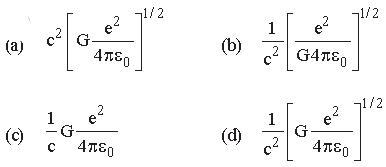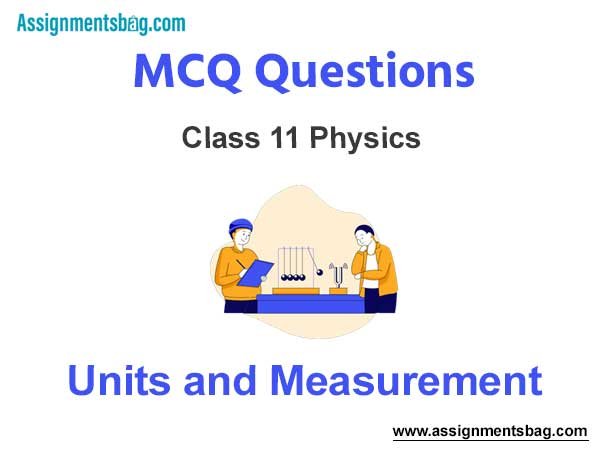Please refer to MCQ Questions Chapter 2 Units and Measurement Class 11 Physics with answers provided below. These multiple-choice questions have been developed based on the latest NCERT book for class 11 Physics issued for the current academic year. We have provided MCQ Questions for Class 11 Physics for all chapters on our website. Students should learn the objective based questions for Chapter 2 Units and Measurement in Class 11 Physics provided below to get more marks in exams.
Chapter 2 Units and Measurement MCQ Questions
Please refer to the following Chapter 2 Units and Measurement MCQ Questions Class 11 Physics with solutions for all important topics in the chapter.
MCQ Questions Answers for Chapter 2 Units and Measurement Class 11 Physics
Question. The number of significant figures in 0.06900 is
(a) 5
(b) 4
(c) 2
(d) 3
Answer
B
Question. Which of the following measurement is most precise?
(a) 5.00 mm
(b) 5.00 cm
(c) 5.00 m
(d) 5.00 km
Answer
A
Question. The sum of the numbers 436.32, 227.2 and 0.301 in appropriate significant figures is
(a) 663.821
(b) 664
(c) 663.8
(d) 663.82
Answer
B
Question. The length and breadth of a rectangular sheet are 16.2 ± 0.1 cm and 10.1 ± 0.1 cm, respectively. The area of the sheet in appropriate significant figures and error is
(a) 164 ± 3 cm2
(b) 163.62 ± 2.6 cm2
(c) 163.6 ± 2.6 cm2
(d) 163.62 ± 3 cm2
Answer
A
Question. Measure of two quantities along with the precision of respective measuring instrument is
A = 2.5 ms–1 ± 0.5 ms–1,
B = 0.10 s ± 0.01 s. The value of AB will be
(a) (0.25 ± 0.08) m
(b) (0.25 ± 0.5) m
(c) (0.25 ± 0.05) m
(d) (0.25 ± 0.135) m
Answer
A
Question. The mean length of an object is 5 cm. Which is the following measurement is most accurate?
(a) 4.9 cm
(b) 4.805 cm
(c) 5.25 cm
(d) 5.4 cm
Answer
A
Question. The dimensional formula of Reynold’s number is :
(a) [MLT]
(b) [M0L0T]
(c) [M0L0 T0j
(d) none of these
Answer
C
Question. Which of the following pairs of physical quantities does not have same dimensional forrmula?
(a) Work and torque
(b) Angular momentum and Planck’s constant
(c) Tension and surface tension
(d) Impulse and linear momentum
Answer
C
Question. The dimensions of time constant are :
(a) [M0L0T0]
(b) [M0L0T]
(c) [MLT]
(d) none of these
Answer
B
Question. Young’s modulus of steel is 1.9 × 1011 N/m2. When expressed in CGS units of dyne/cm2, it will be equal to (1N = 105 dyne, 1 m2 = 104 cm2)
(a) 1.9 × 1010
(b) 1.9 × 1011
(c) 1.9 × 1012
(d) 1.9 × 1013
Answer
C
Question. If momentum (p), area (A) and time (T) are taken to be fundamental quantities, then energy has the dimensional formula
(a) [pA–1T1]
(b) [p2AT]
(c) [pA–1/2T]
(d) [ pA1/2T]
Answer
D
Question. Which of the following is not correct for dimensionless quantity ?
(a) It does not exist
(b) It always has a unit
(c) It never has a unit
(d) It may have a unit
Answer
B
Question. The dimensional representation of gravitational potential is identical to that of:
(a) internal energy
(b) angular momentum
(c) latent heat
(d) electric potential
Answer
C
Question. In an experiment four quantities a, b, c and d are measured with percentage error 1%, 2%, 3% and 4% respectively. Quantity P is calculated as follows P = (a3b2/cd)
(a) 10%
(b) 7%
(c) 4%
(d) 14%
Answer
D
Question. The pair of quantities having same dimensions is
(a) Young’s modulus and energy
(b) impulse and surface tension
(c) angular momentum and work
(d) work and torque
Answer
D
Question. You measure two quantities as A = 1.0 m ± 0.2 m, B = 2.0 m ± 0.2 m. We should report correct value for √AB as
(a) 1.4 m ± 0.4 m
(b) 1.41 m ± 0.15 m
(c) 1.4 m ± 0.3 m
(d) 1.4 m ± 0.2 m
Answer
D
Question. If force (F), velocity (V) and time (T) are taken as fundamental units, then the dimensions of mass are :
(a) [F V T– 1]
(b) [F V T– 2]
(c) [F V– 1 T– 1]
(d) [F V– 1 T]
Answer
D
Question. If energy (E), velocity (V) and time (T) are chosen as the fundamental quantities, the dimensional formula of surface tension will be :
(a) [EV–1T–2]
(b) [EV–2T–2]
(c) [E–2V–1T–3]
(d) [EV–2T–1]
Answer
B
Question. A physical quantity of the dimensions of length that can be formed out of c, G and e2/4π∈0

Answer
D
Question. Which of the following quantities is not dimensionless ?
(a) Reynold’s number
(b) Strain
(c) Angle
(d) Radius of gyration
Answer
D
Question. If dimensions of critical velocity uc of a liquid flowing through a tube are expressed as [πxryrx ] , where h, r and r are the coefficient of viscosity of liquid, density of liquid and radius of the tube respectively, then the values of x, y
and z are given by :
(a) –1, –1, 1
(b) –1, –1, –1
(c) 1, 1, 1
(d) 1, –1, –1
Answer
D
Question. Which of the following pairs have same dimensions ?
(a) Torque and work
(b) Angular momentum and work
(c) Energy and Young’s modulus
(d) Light year and wavelength
Answer
A
Question. If v = (A/t) + Bt2 + Ct3 where v is velocity, t is time and A, B and C are constant then the dimensional formula of B is :
(a) [M0LT0]
(c) [M0L0T]
(b) [ML0 T0]
(d) [M0LT-3]
Answer
D
Question. The volume of cube is equal to surface area of the cube. The volume of cube is :
(a) 216 unit
(b) 512 unit
(c) 64 unit
(d) none of these
Answer
A
Question. Taking density (p), velocity (v) and area (a) to be fundamental unit then the dimensions of force are :
(a) [av p]
(b) [a2vp]
(c) [avp2]
(d) [Ap]
Answer
A
Question. Which of the following physical quantities has neither dimensions nor unit ?
(a) Angle
(b) Luminous intensity
(c) Coefficient of friction
(d) Current
Answer
C
Question. Which of the following is dimensionally correct ?
(a) Specific heat = joule per kilogram kelvin
(b) Specific heat = newton per kilogram kelvin
(c) Specific heat = joule per kelvin
(d) None of the above
Answer
A
Question. The dimensions of radian per second are :
(a) [M0L0T0]
(b) [M0L0T]
(c) [M0L0T-1]
(d) none of these 2j
Answer
C
Question. The dimensional formula of compressibility is :
(a) [M0L-1 T-1]
(b) [M-1LT2]
(c) [MLT ]
(d) none of these
Answer
B
Question. State which of the following is correct ?
(a) joule = coulomb x volt
(b) joule = coulomb/volt
(c) joule = volt + coulomb
(d) joule = volt/coulomb
Answer
A
Question. Velocity gradient has same dimensional formula as:
(a) angular frequency
(b) angular momentum
(c) velocity
(d) none of these
Answer
A
Question. When pheiridippides run from Marathon to Athans in 490 B.C. to bring word of the Greek victory over the persians on the basis of approximate measurement, he ran at a speed of 23 ride per hour. The ride is an ancient Greek unit for distance, as are the stadium and the pletheron. One ride was defined to be 4 stadium, one stadium was defined to be 6 pletheran and in terms of SI unit, one pletheron is 30.8 m. How fast did pheiridippides run in m/s ?
(a) 5.25 m/s (approx)
(b) 4.7 m/s (approx)
(c) 11.2 m/s (approx)
(d) 51.75 m/s (approx)
Answer
B
Question. Which one of the following pairs of quantities and their unit is properly matched?
(a) Electric field-coulomb/m
(b) Magnetic flux- Weber/m2
(c) Power-Farad
(d) Capacitance-Henry
Answer
B
Question. The SI unit of electrochemical equivalent is
(a) kg C
(b) C kg1
(c) kg C1
(d) kg2 C1
Answer
C
Question. One light year is defined as the distance travelled by light in one year. The speed of light is 3 x 108 m/s. The same in metre is :
(a) 3 x 1012 m
(b) 9.461 x 1015 m
(c) 3 x 1015 m
(d) none of these
Answer
B
Question. The dimensional formula of electrical conductivity is :
(a) [M-1L-3T3A2]
(b) [ML3T3A2]
(c) [M2L3T-3A2]
(d) [ML3T-3A-2]
Answer
A
Question. An atmosphere:
(a) is a unit of pressure
(b) is a unit of force
(c) gives an idea of the composition of air
(d) is the height above which there is no atmosphere
Answer
A
Question. The dimensions of self-inductance are :
(b) [ML2T-1A-2]
(a) [MLT-2A-2]
(c) [ML2T-2A-2]
(d) [ML2T-2A2]
Answer
C
Question. Which of the following pair has same dimensions ?
(a) Current density and charge density
(b) Angular momentum and momentum
(c) Spring constant and surface energy
(d) Force and torque
Answer
C
Question. The speed of light in vacuum is 3 x 108 m/s. How many nano second does it take to travel one metre in a vacuum ?
(a) 8 ns
(b) 10/3ns
(c) 3.34 ns
(d) none of these
Answer
B
Question. The time taken by an electron to go from ground state to excited state is one shake (one shake = 108 s). This time in nanosecond will be :
(a) 10 ns
(b) 4 ns
(c) 2 ns
(d) 25 ns
Answer
A
Question. The mass and volume of a body are 4.237 g and 2.5 cm3, respectively. The density of the material of the body in correct significant figures is
(a) 1.6048 g cm–3
(b) 1.69 g cm–3
(c) 1.7 g cm–3
(d) 1.695 g cm–3
Answer
C
Question. Taking frequency f, velocity v and density p to be the fundamental quantities then the dimensional formula for momentum will be:
(a) pv4f-3
(b) pv3f-1
(c) pvf2
(d) p2V2f2
Answer
A
Question. The amount of water in slug containing by a cylindrical vessel of length 10 cm and cross-sectional radius 5 cm is (The density of water is 1000 kg/m3) :
(a) 157 x 10 -3 slug
(b) 53.76 x l0-3 slug
(c) 10.7 slug
(d) 14.6 slug
Answer
B
Question. The equation of alternating current I = I0 e– t/CR, where t is time, C is capacitance and R is resistance of coil, then the dimensions of CR is :
(a) [MLT-1]
(b) [M0LT]
(c) [M0L0T]
(d) none of these
Answer
C
Question. If P represents radiation pressure, C represents speed of light and Q represents radiation energy striking a unit area per second then non zero integers a, b and c such that PaQbCc is dimensionless, are :
(a) a = 1,b = 1,c =- 1
(b) a = 1,b = -1,c =1
(c) a=-1l,b = 1,c = 1
(d) fl = 1,& = 1,c = 1
Answer
B
Question. Farad is not equivalent to :
(a) q/v
(c) qv2
(b) q2/J
(d) J/v2
(q = coulomb, V = volt, / = joule)
Answer
B
Question. The capacity of a vessel is 5700 m3 . The vessel is filled with water. Suppose that it takes 12 hours to drain the vessel. What is the mass flow rate of water from the vessel ? [The density of water is 1 g/cm3]
(a) 132 kg/s
(b) 100 kg/s
(c) 32 kg/s
(d) 152 kg/s
Answer
A
Question. The height of the building is 50 ft. The same in millimetre is :
(a) 560 mm
(b) 285 mm
(c) 1786.8 mm
(d) 15240 mm
Answer
D
Question. The name of the nearest star is proxima centauri. The distance of this star from Earth is 4 x 1016 m. The distance of this star from Earth in mile is :
(a) 3.5 x l013 mile
(b) 2.5 x l013 mile
(c) 5.3 x l013 mile
(d) 1.5 x l013 mile
Answer
B
Question. One light year is defined as the distance travelled by light in one year. The speed of light3 x 108 ms-1. The same in metre is
(a)3 x 1012m
(b) 9 461 x 1015m
(c)3 x 1015m
(d) None of these
Answer
B
Question. One slug is equivalent to 14.6 kg. A force of 10 pound is applied on a body of 1 kg. The acceleration of the body is
(a) 44.5 ms-2
(b) 4.448 ms-2
(c) 44.4 ms-2
(d) None of these
Answer
A
Question. The expression for centripetal force depends upon mass of body, speed of the body and the radius of circular path. Find the expression for centripetal force:

Answer
B
Question. lf x = a sin θ + b cos θ/a+b, then :
(a) the dimensions of x and a are same
(b) the dimensions of a and b are not same
(c) x is dimensionless
(d) none of the above
Answer
C
Question. Young modulus of steel is 1.9 x 1011 N/m2. When expressed in CGS units of dyne/cm2, it will be equal to (1N =105 dyne, 1m2 = 104 cm2 )
(a) 1.9 x 1010
(b) 1.9 x 1011
(c) 1.9 x 1012
(d) 1.9 x 1013
Answer
C
Question. Universal time is based on
(a) rotation of earth on its axis
(b) oscillations of quartz crystal
(c) vibrations of cesium atom
(d) earth’s orbital motion around the sun
Answer
A
Question. Which of the following cannot be regarded as an essential characteristic of a unit of measurement?
(a) Inaccessibility
(b) Indenstructibility
(c) Invariability
(d) Reproductibility
Answer
A
Question. In the relation y = rsin (ϖt – kx), the dimensional formula of ‘/ k are
(a) [M L T ] 0 0 0
(b) [M L T ] 0 1 -1
(c) [M L T ] 0 0 1
(d) [M L T ] 0 1 0
Answer
B
Question. The sum of numbers 436.32, 227.2 and 0.301 in appropriate significant figures in
(a) 663.821
(b) 664
(c) 663.8
(d) 663.82
Answer
B
Question. A sextant is used to measure
(a) area of hill
(b) height of an object
(c) breadth of a tower
(d) volume of the building
Answer
B
Question. Energy per unit volume represents
(a) pressure
(b) force
(c) thrust
(d) work
Answer
A
Question. Which of the following pairs of physical quantities does not have same dimensional formula?
(a) Work and torque
(b) Angular momentum and Planck’s constant
(c) Tension and surface tension
(d) Impulse and linear momentum
Answer
B

We hope you liked the above provided MCQ Questions Chapter 2 Units and Measurement Class 11 Physics with solutions. If you have any questions please ask us in the comments box below.

